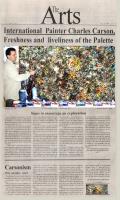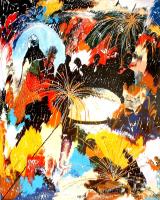 |
|
|
The Arts
The Colombian Post, Miami
Dec. 26, 1997
International Painter Charles Carson, Freshness and liveliness of the Palette
Signs to encourage an exploration
Born in Montreal, Canada on March, 1957, Fifth in a Family of 10. His passion was fueled during his childhood in 1970 when he starts painting landscapes and abstractions and the reproducing Rembrandt and Da Vinci work.
Charles Carson set a basic rule for himself when he began in the mysterious world of painting around 1978. He would not move into the art market before reaching his own objective which was to create a new form of painting that in no way resembled any past or present form or style. He devoted fourteen years to work, research, experimenting and discipline, never taking the easy way out, before discovering the colorful, luminous and spontaneous pictorial expression that is his today.
Charle’s Carson’s bold and fascinated chromatic compositions remind us of what Kandinsky wrote in 1910 in "Uber das geistige in der kunst (The Spiritual in Art) "The boldness of color in a painting must attract the spectator forcefully and at the same time mask the deeper content. The colors of Carson’s palette do not mask, they slowly reveal with equal depth what they seem to hide initially and still succeeded in maintaining the spectator’s entire attention as he more or less consciously continues to seek out new elements.
Painting is almost visceral need with Charles Carson. Yet, he reflects complacency or more specifically creating popular paintings to please anyone and everyone at any price.
It bears repeating that Charles Carson’s art is not abstract and if some specialists consider it to be such, they should add that it is a much lesser degree of abstraction than pure abstraction. Very recognizable figurative forms immersed in a world of relatively undefined configurations perhaps, but always directly related to the dominant elements.
Nothing is left to chance; the relationship between the artist and nature is immediately defined. What is curious, however, is that one or several elements are always carefully and strangely hidden only to be revealed gradually to the receptive….and patient spectator
|

|
|
"Le cirque de Shangaï"
|
The perfect coordination of planes, the harmony of rhythm, the dynamic organization and brilliance of Carson’s palette bring to mind the best and wonderful Riopelles of the 50s and 60s.
Charles Carson is not a non-figurative painter within the meaning of this term. His painting must be viewed as a detailed group of everyday things, some of which are immediately obvious while others can only be discovered after contemplation. None of the objects he paints are really or truly deformed in spite of their appearance which is due rather to the effervescent colors : after a few seconds of visual meditation, they appear in a reality all their own.
In terms of investment, what was true twenty years ago remains true today, even more so than ever. In the book "Investing in Works of Art" published in 1978, I wrote that there were two types of investment: aesthetic investment, and what doesn’t hurt at all, financial investment. And referring to collections, I added that a large fortune has been built by systematically collecting painting. In 1976, when questioned by a shareholder who was concerned about money spent acquiring painting, David Rockefeller scathingly replied: "These investments cost US $500.000 and are worth more than US$3 million today. Do you know of a more profitable sector"
The Rockefellers are not neophytes in the art of investing and making money and as far as collecting was concerned, they certainly were not purchasing painting blindly but were probably seeking out quality artists as best investments. The works of Charles Carson are an example of a good investment since they are constantly sought after by investors and collectors.
BY LOUIS BRUENS
ART CONSULTANT WHO SPECIALIZES IN INVESTMENT.
|
|
|